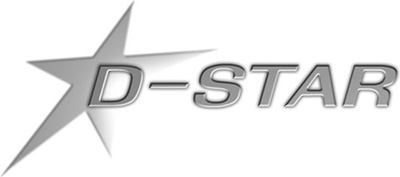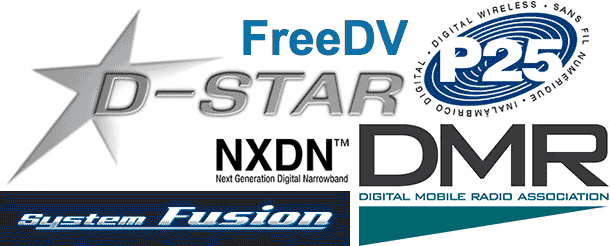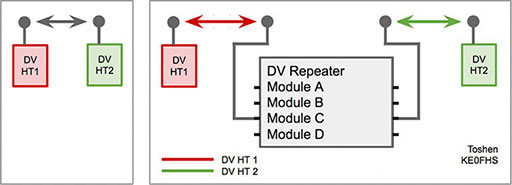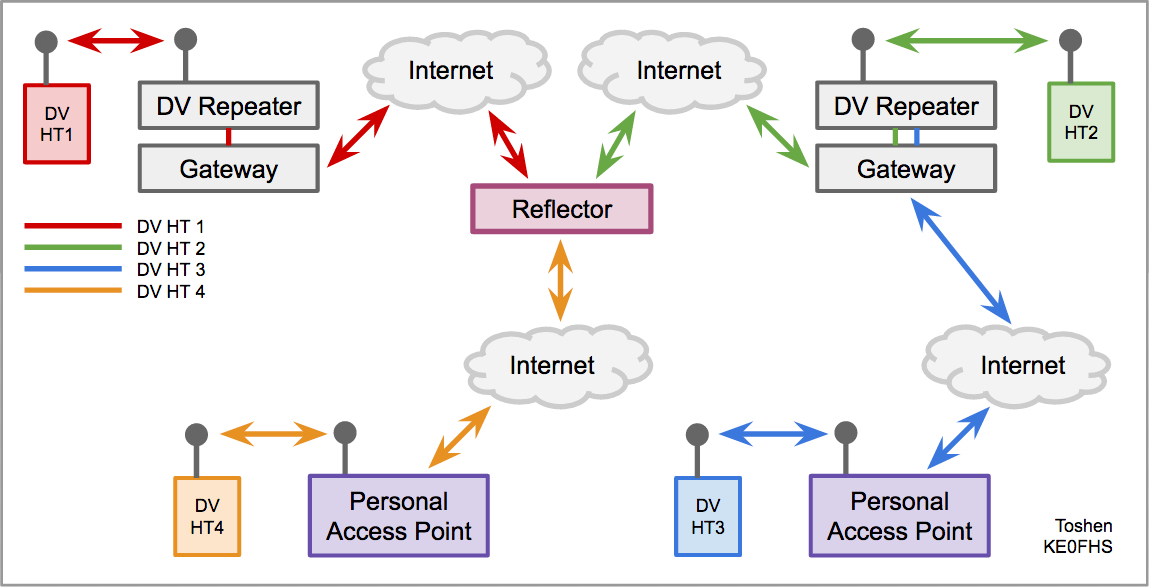Diving into D-STAR – 1

The D-STAR logo is a
registered trademark of Icom
Revised: Jan 2023; CC BY-SA![]()
As of Jan 1, 2024, this site is no longer being updated. It will remain available for some time for legacy reference.
Most up-to-date version: amateurradionotes.com/d-star.htm
Disclaimer: These are my personal notes and opinions based on my experience using D-STAR, as well as by learning from what others are sharing. I pay for all my equipment and do not accept freebies in exchange for reviews. If anything needs correcting, please let me know![]() .
.
Why bother?
When I first dove into D-STAR, I knew nearly nothing about digital voice and quickly found myself drowning in a big bowl of bewilderingly murky information soup. So if it's that bewildering, why even bother?
I'll jump a bit ahead here and share one tidbit: at one point early in my exploration of D-STAR, I linked to a reflector and heard a guy in San Diego, California chatting with a chap in Yorkshire, England. That was the moment I became hooked. Just think of it: worldwide communication with a Technician class license, a bit of effort and learning, and some fairly simple, relatively inexpensive equipment!
Of course, the real goal isn't to just listen but to actually chat with people. This is the story of how I got there.
Today's amateur radio experimenter is as likely to use a keyboard as a soldering iron for experiments, and as a digital enthusiast, I can only cheer and encourage you to get involved and have some fun.
– Don Rotolo, N21RZ, Vocoding: Creating Digital Voice
1) What is digital voice?
The simple answer is that digital voice (DV) uses digital rather than analog audio. But what does that really mean? For me, it was all quite murky when I first started looking into it, and it took me quite a bit of exploring and head scratching to begin figuring it out.
This section provides an introduction to the basics of digital voice and personal, low-power hotspots, including links to some helpful websites, articles, and other content, in case you want to dive in more deeply. You also can find all the links together on the Notes page at the end of this article: Links to helpful resources![]() .
.
1a) Alphabet soup
As I began flailing around in the digital voice murkiness, one of the first things I figured out is that it's actually a bit like a big bowl of alphabet soup … it's absolutely crazy how many acronyms are floating around!

Alphabetsoupese by Toshen, KE0FHS
Derived from an original photo![]()
by Leo Reynolds![]() . Some rights reserved
. Some rights reserved![]() .
.
Even worse, sometimes the acronyms are spelled out differently, which makes searching for information more challenging. Other times, it isn't easy to determine what an acronym actually stands for, for example, I've seen DCS defined three different ways (Digital Call Server, Digital Communication Systems, and Digital Call Service), and I'm still unsure which is correct. Perhaps it stands for Darn Confusing Stuff?!
Since there's no avoiding this craziness, you just have to accept it as part of the price of admission. And don't worry, by the end of this article, you'll be speaking "Alphabetsoupese" fluently!
1b) Multiple systems
The next thing I understood is that D-STAR is just one of several digital voice systems being developed, though it's one of the earliest, and the first to be developed specifically for amateur radio use.

The Japan Amateur Radio League began development work on the Digital Smart Technologies for Amateur Radio (D-STAR) standard in the late 1990s and published it in 2001. It started to gain traction in the U.S. around 2006.
The D-STAR standard has been adopted primarily by two first-tier amateur radio equipment makers, first by Icom, the D-STAR trailblazer, and more recently by Kenwood. By now, it's being used by tens of thousands of amateur radio enthusiasts worldwide.
It's also an open standard (with the exception of the vocoder chip, which is discussed in the following note), so it's being used for lots of experimentation, and that means there's some interesting homebrew and small manufacturer hardware and software available.
Other digital voice systems being developed or adapted for use by hams:
- DMR
 , an open commercial standard developed and governed by the European Telecommunications Standards Institute, with equipment by Motorola, Hytera, Tytera, and others. Rapidly growing in the amateur radio community, with well over 100,000 hams with CCS7 IDs by 2019.
, an open commercial standard developed and governed by the European Telecommunications Standards Institute, with equipment by Motorola, Hytera, Tytera, and others. Rapidly growing in the amateur radio community, with well over 100,000 hams with CCS7 IDs by 2019. - System Fusion
 , a proprietary system for amateur radio by Yaesu.
, a proprietary system for amateur radio by Yaesu. - P25
 , a standard developed for North American public safety services. Governed by the Telecommunications Industry Association and others.
, a standard developed for North American public safety services. Governed by the Telecommunications Industry Association and others. - NXDN
 , an open commercial and public safety standard initially developed by Icom (implemented as IDAS) and Kenwood (implemented as NEXEDGE), and now overseen by members of the NXDN Forum.
, an open commercial and public safety standard initially developed by Icom (implemented as IDAS) and Kenwood (implemented as NEXEDGE), and now overseen by members of the NXDN Forum.  There also are a couple open systems slowly being developed for amateur radio, which are based on an open source speech codec (vocoder) called Codec 2
There also are a couple open systems slowly being developed for amateur radio, which are based on an open source speech codec (vocoder) called Codec 2 . One is the M17 Project
. One is the M17 Project (more M17 info
(more M17 info ), and the other is called FreeDV
), and the other is called FreeDV . Thomas, W2XQ, has a good section of links to M17 resources⩘ on his site. For current info on the M17 and OpenHT projects: M17 Project on Mastodon
. Thomas, W2XQ, has a good section of links to M17 resources⩘ on his site. For current info on the M17 and OpenHT projects: M17 Project on Mastodon .
.
1c) Transceivers, repeaters, and reflectors … oh my!
Just as you can use analog transceivers in FM mode, you can use digital voice-capable transceivers in DV mode to talk directly from radio to radio simplex 1 or via a repeater (as long as it's a digital voice repeater).

[1] The U.S. DV simplex frequencies are 145.670 (2 M) and 446.225 (70 cm).
Here's an example of the setup of DV mode radio-to-radio call via a DV repeater:
Radio: DV HT1 DV HT2
Freq: 446.8625 446.8625
UR CALL: CQCQCQ CQCQCQ
RPT1: KC0DS B KC0DS B
RPT2:
MY CALL: KE0FHS N0AES
It gets even more interesting when digital voice repeaters are bridged together using D-STAR Repeater (DR) mode (a.k.a, Duplex mode), enabling groups of people, even far flung, to participate in something that's like a conference call.

Example of DR mode setup for linking to a reflector via local repeaters:
Radio: DV HT1 DV HT2
Freq: 446.8625 145.2500
UR CALL: REF001CL REF001CL
RPT1: KC0DS B W0CDS C
RPT2: KC0DS G W0CDS G
MY CALL: KE0FHS N0AES
After linking to the reflector, everything is the same except:
UR CALL: CQCQCQ CQCQCQ
Linking together in this way to participate in a call or net is a big part of what playing around in the worldwide D-STAR playground is all about.
In the D-STAR world, this technology is called "Reflectors" (transmissions are reflected to all repeaters linked to the reflector), while DMR calls it "Talkgroups" and System Fusion calls it "Rooms." D-STAR also has a new open routing system called QuadNet Smart Groups![]() , which bridges users together in a similar fashion.
, which bridges users together in a similar fashion.
Here, too, there are multiple systems being developed and used simultaneously. Within just the D-STAR world, there are four main reflector systems as well as the open routing system:
- REF – The DPLUS reflector system, a closed proprietary system developed by Robin Cutshaw, AA4RC, is the first generation of D-STAR reflectors and still much in use, especially in English-speaking countries. An example is REF001 in London, referred to as D-STAR's "Mega Reflector." REF directory
 .
. - XRF – The Dextra X-Reflector system, originally created by Scott Lawson, KI4KLF, is the second generation of D-STAR reflectors and is open source. XRF directory
 .
. - DCS – The Digital Call Server reflector system, a closed system developed by Torsten Schultze, DG1HT, and now run by Stefan, DL1BH, Peter, DG9FFM, and Rolf, HB9SDB. DCS updates and directory
 .
. - XLX – The XLX reflector system, being developed by Jean-Luc Boevange, LX3JL, and Luc Engelmann, LX1IQ, is an open system and the newest, which they describe
 as "the first and only multiprotocol Reflector system until now and supports all standard D-STAR protocols like DCS, Dextra and DPlus fully transparent." XLX reflectors directory
as "the first and only multiprotocol Reflector system until now and supports all standard D-STAR protocols like DCS, Dextra and DPlus fully transparent." XLX reflectors directory .
. - Smart Groups – The QuadNet open style routing system, is based on an idea called STARnet by John Hays, K7VE, and first implemented by Jonathan Naylor, G4KLX, as StarNetServer. Tom, N7TAE, Colby, W1BSB, and the QuadNet
 team is now taking this idea to the next level with their new Smart Group Server: "A routing group is kind of like a reflector, but it is actually more like a repeater without the RF transceiver. A routing group can have many individual users 'subscribed' to it. Anyone subscribed to a group will hear all traffic on the Group."
team is now taking this idea to the next level with their new Smart Group Server: "A routing group is kind of like a reflector, but it is actually more like a repeater without the RF transceiver. A routing group can have many individual users 'subscribed' to it. Anyone subscribed to a group will hear all traffic on the Group."
- To learn more:
- Reflections on Reflectors: A basic tutorial on DSTAR reflectors
 , 2018, by Bob Scott, W6KD.
, 2018, by Bob Scott, W6KD. - QuadNet2 USA IRC Network
 – D-STAR routing done open style!
– D-STAR routing done open style! - See also: QuadNet Smart Groups
 .
.
Fenced playgrounds
While there are some differences between the digital voice systems being used by hams—D-STAR, DMR, System Fusion, P25, NXDN—they share many similarities. Given their shared similarities, perhaps the most surprising thing is that they don't talk to each other. They are like three side-by-side playgrounds, all with similar swing sets and slides, but with arbitrary fences separating them.
Breaking down the fences
Fortunately, real progress breaking down the fences between the digital playgrounds began being made in 2018. An encouraging trend is the way newer hotspots have been incorporating software-based cross-mode transcoding capabilities. Both the MMDVM-based hotspots running Pi-Star and the SharRF openSPOT have supported software-based cross-modes for awhile now, for example: YSF2DMR, YSF2NXDN, YSF2P25, DMR2YSF, and DMR2NXDN.
Even better, in early 2020, SharkRF launched the openSPOT 3 hotspot. In addition to supporting software-based transcoding, it also incorporates some hardware-based transcoding, which finally will mean bridging DSTAR with some of the other modes.
The future?
Given the small size of the openSPOT 3, I hope it will be only a matter of time before these capabilities are incorporated right into the radios themselves. Want to talk over RF? Fine! Want to talk over the internet? Fine! Want to talk with someone using a different system? Fine! Hopefully, what will eventually matter most is who you want to talk with, more so than their type of equipment.
1d) Hotspots (Personal access points)
This is where it gets really exciting and fun, at least for me. One more piece of the puzzle is figuring out how to get onto the digital system when you're not within radio range of a digital voice repeater.
Fortunately, there are innovative hams creating personal, low-power hotspots and software that enable a ham with internet connectivity to link directly to reflectors or DV repeaters (again, typically using DR or Duplex mode), bypassing the need to transmit from the radio to a DV repeater first. Basically, these hotspots act as your own personal repeater and gateway.

Example of DR mode setup for linking to a reflector via a hotspot:
Radio: DV HT4
Freq: 446.2250
UR CALL: REF030CL
RPT1: KE0FHS B
RPT2: KE0FHS G
MY CALL: KE0FHS
After linking to the reflector, everything is the same except:
UR CALL: CQCQCQ
For more details about the setup for using a hotspot, see:
First QSO via a reflector!![]()
Linking to a D-STAR repeater![]() .
.
There's another nice aspect of the personal, low-power hotspots: since you link directly to a reflector via a hotspot, you don't tie up a DV repeater the way you would if you use your radio to send a command to the repeater to link it via its gateway to a reflector for your personal call on that reflector. This may make a hotspot interesting even for someone who lives within range of a DV repeater.

